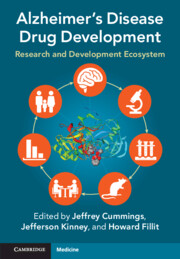Book contents
- Alzheimer’s Disease Drug Development
- Alzheimer’s Disease Drug Development
- Copyright page
- Dedication
- Contents
- Contributors
- Foreword
- Acknowledgments
- Section 1 Advancing Alzheimer’s Disease Therapies in a Collaborative Science Ecosystem
- Section 2 Non-clinical Assessment of Alzheimer’s Disease Candidate Drugs
- 7 Role of Animal Models in Alzheimer’s Disease Drug Development
- 8 Use of Induced Pluripotent Stem Cell-Derived Neuronal Disease Models from Patients with Familial Early-Onset Alzheimer’s Disease in Drug Discovery
- 9 Preclinical Longitudinal In Vivo Biomarker Platform for Alzheimer’s Disease Drug Discovery
- 10 Biobanking and Biomarkers in the Alzheimer’s Disease Drug-Development Ecosystem
- Section 3 Alzheimer’s Disease Clinical Trials
- Section 4 Imaging and Biomarker Development in Alzheimer’s Disease Drug Discovery
- Section 5 Academic Drug-Development Programs
- Section 6 Public–Private Partnerships in Alzheimer’s Disease Drug Development
- Section 7 Funding and Financing Alzheimer’s Disease Drug Development
- Index
- References
10 - Biobanking and Biomarkers in the Alzheimer’s Disease Drug-Development Ecosystem
from Section 2 - Non-clinical Assessment of Alzheimer’s Disease Candidate Drugs
Published online by Cambridge University Press: 03 March 2022
- Alzheimer’s Disease Drug Development
- Alzheimer’s Disease Drug Development
- Copyright page
- Dedication
- Contents
- Contributors
- Foreword
- Acknowledgments
- Section 1 Advancing Alzheimer’s Disease Therapies in a Collaborative Science Ecosystem
- Section 2 Non-clinical Assessment of Alzheimer’s Disease Candidate Drugs
- 7 Role of Animal Models in Alzheimer’s Disease Drug Development
- 8 Use of Induced Pluripotent Stem Cell-Derived Neuronal Disease Models from Patients with Familial Early-Onset Alzheimer’s Disease in Drug Discovery
- 9 Preclinical Longitudinal In Vivo Biomarker Platform for Alzheimer’s Disease Drug Discovery
- 10 Biobanking and Biomarkers in the Alzheimer’s Disease Drug-Development Ecosystem
- Section 3 Alzheimer’s Disease Clinical Trials
- Section 4 Imaging and Biomarker Development in Alzheimer’s Disease Drug Discovery
- Section 5 Academic Drug-Development Programs
- Section 6 Public–Private Partnerships in Alzheimer’s Disease Drug Development
- Section 7 Funding and Financing Alzheimer’s Disease Drug Development
- Index
- References
Summary
Biobanks and biomarker discovery workflows have grown to be an essential piece of clinical trial research to advance candidate therapeutics. While initially biobanks were established for safety and tolerability examinations they now provide data on inclusion measures for clinical trials, as well as numerous outcome measures that inform on target engagement to disease-modifying effects. This process is complex as there is tremendous need for standardization of everything from sample collection and storage to reproducibility of experimental data. With biomarker discovery capabilities advancing at a rapid pace novel techniques in various samples have also become part of the biobank workflow. In this chapter we highlight some of the prevailing considerations in biobanking and biomarker discovery. We also highlight the approaches that are emerging as the next steps in biomarker discovery in Alzheimer’s disease clinical trial research.
Keywords
- Type
- Chapter
- Information
- Alzheimer's Disease Drug DevelopmentResearch and Development Ecosystem, pp. 123 - 134Publisher: Cambridge University PressPrint publication year: 2022

